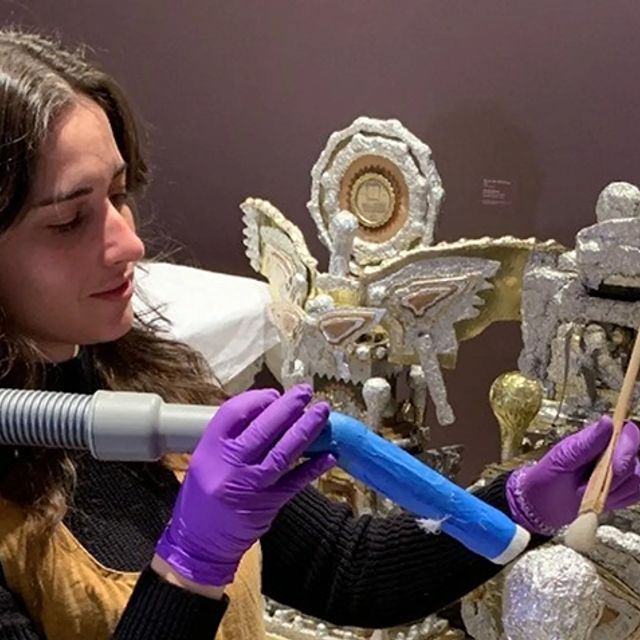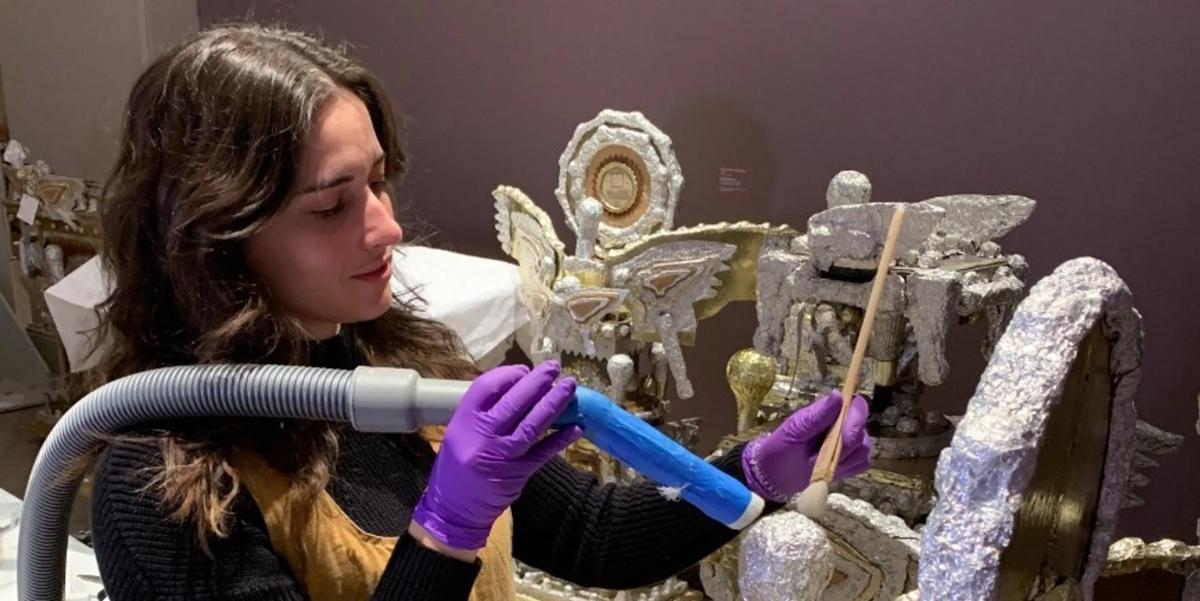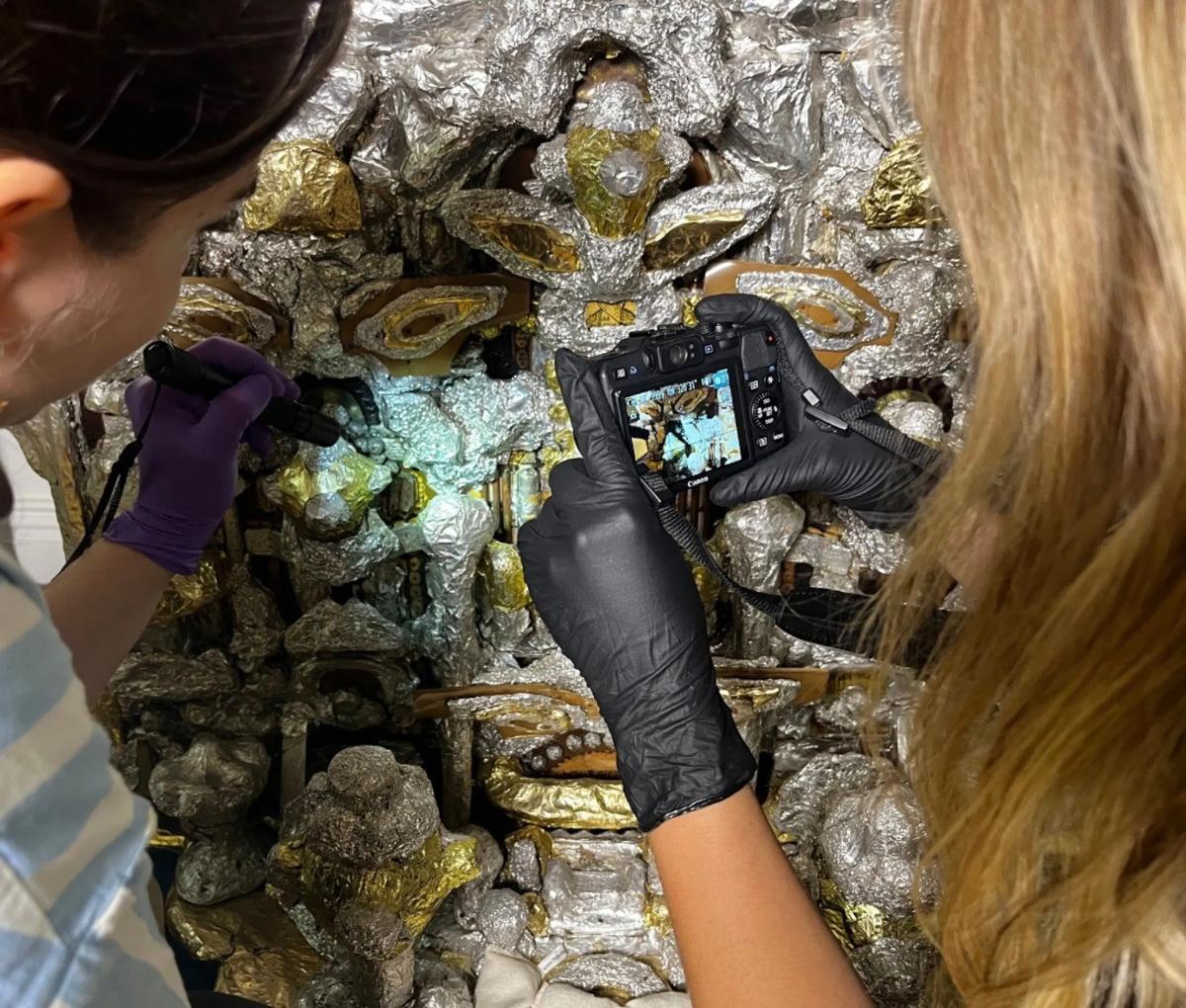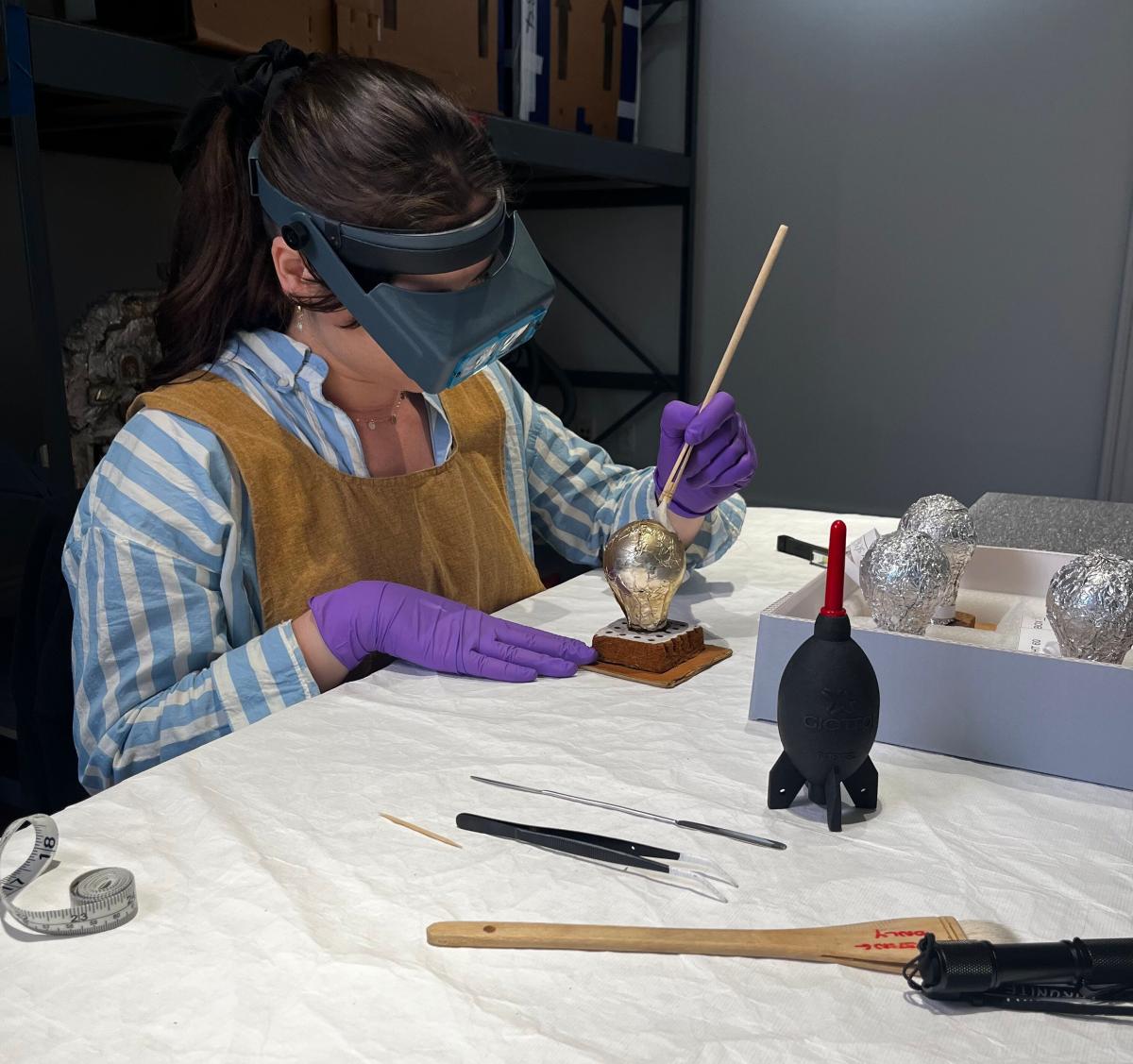Do you ever wonder about all the art not on view at a museum? At the Smithsonian American Art Museum's Lunder Conservation Center, visitors can observe how conservators and collection staff prepare works for exhibition and travel, and how they provide overall care for our collections.
Most of the conservation work at SAAM happens in the Lunder's publicly visible labs, but certain projects require alternate spaces. Some artworks are affixed to specific locations (outdoor sculptures, for example), too heavy to easily move, too delicate to withstand excessive movement, and some are simply too big or complicated to fit in the space. James Hampton’s The Throne of the Third Heaven of the Nations Millennium General Assembly, a multipiece installation artwork, falls in the latter category, presenting our team with a unique set of challenges.
The Throne of the Third Heaven is a large-scale artwork composed of found and repurposed everyday materials, including furniture, colored papers, cardboard, aluminum foil, wrapping paper, lightbulbs, vases, and jelly jars. Hampton likely sought materials that were readily available, and in one way or another, beautiful or full of potential. This monumental work of art was created from 1950-1964 in a rented carriage house in the Shaw neighborhood of Washington, DC. Hampton sourced his materials from places he frequented, such as the government building where he worked as a janitor, the city streets, and thrift shops. Inspiration was drawn from the Bible and its Book of Revelation to bring his vision to life: a constellation of winged stands, pulpits, plaques, crowns, tables, sculptural vases and, namely, a winged throne.
Looking at The Throne of the Third Heaven you can see the great care the artist took in ensuring that not only were his pieces well-constructed, but also that paired or related objects within the array were similarly sized to create a cohesive appearance. Hampton’s transformation of commonplace materials into this room-sized artwork is visually magnificent. The sheer scale of the artwork and Hampton’s attention to detail speak to his inspiring drive to create.
Something visitors may not know about The Throne of the Third Heaven is that it is comprised of hundreds of individual components, only a portion of which are on view in SAAM’s galleries for folk and self-taught art. While the displayed portion covers an entire wall, the remaining elements have been the subject of a comprehensive long-term inventory, examination, and treatment project. Conservators and registrars examine the artwork and gain insight into Hampton’s use of unconventional materials as well as his construction methods, creating a plan for the care necessary for ensuring this monumental artwork will endure over time.
When an artwork comes into SAAM’s collection, registrars and collections managers are responsible for safe handling, storage, and essential record-keeping necessary for long-term stewardship. SAAM conservators are experts in the physical properties of artworks. Thorough documentation is required before, during, and after any treatment, so that future conservators understand an object’s known history, including any past treatments.
Katya Zinsli, the Lunder Conservation Fellow working on the project, documents each of these works with detailed photography and describes what she observes, such as what materials are present, how they are combined, and what their present condition is. Conservators use an artwork’s “condition” to assess whether an object is deteriorating over time, if so, why, and if they need to intervene to slow it. Conservators keep reports for each object, like a doctor would keep medical records for their patients, to provide snapshots of an object’s condition over time. Zinsli shared, “Having the opportunity to examine each of the components individually has garnered a greater appreciation of Hampton’s working method and artistic style.”
The artist was meticulous and consistent in his layering of materials and use of design motifs, often tracing portions of previously drawn or constructed design elements so he could effectively repeat them elsewhere in this massive artwork. Hampton was also innovative in solving material problems. For example, his use of glue-soaked cloth to fill the empty spaces between disparate materials like glass and cardboard is an ingenious solution to creating a strong adhesive bond.
Zinsli works alongside Eliza Macdonald, the Kim Igoe Advanced Level Intern in Collections Management. Macdonald is responsible for handling, storing and location tracking all components of The Throne of the Third Heaven and assigning each component its own unique identification number. Macdonald explains, “Each object is given a unique number. This acts as a social security number, of sorts, that helps us identify and track its location, as well as organize information collected about each component. Over the last year, Katya and I have spent thousands of hours with The Throne of the Third Heaven, inventorying and assessing hundreds of components. The many hours spent closely evaluating every design element and the overall construction of the objects have given me a deep appreciation for Hampton’s skill and dedication to his vision.”
In the fall of 2023, SAAM opened a temporary satellite lab space in a ground-floor gallery. By inviting visitors into the space, guests were afforded a behind-the-scenes view of Katya and Eliza at work. Anna Nielsen, Program Coordinator at the Lunder Conservation Center, planned and helped oversee these public sessions. She welcomed visitors into the space and worked closely with Melissa Perez, the Gaines Advanced Level Intern in Objects Conservation and Preventive Care, who served as a liaison, encouraging questions and sharing her expertise with visitors. Perez explains, “For many [visitors], it is their first encounter with The Throne of the Third Heaven; for others, this artwork is their first stop when in DC and, at times, even their primary motivation for visiting SAAM, bringing family and friends along. Visitors often came back to thank staff for introducing them to the artwork, sometimes explaining that it moved them to tears.”
Upon seeing The Throne of the Third Heaven, some visitors guessed it was constructed with precious metals such as gold and silver and were surprised to discover that Hampton used inexpensive materials, some of which could be found in their own homes. Over the three-month period the lab was open to the public, almost 3,000 visitors were welcomed into the space, giving the team an opportunity to share what they knew about James Hampton and his inspirational artistry with visitors of all ages and from around the world.
SAAM is the proud home of one of the deepest and most significant collections of work by self-taught artists anywhere in the world and the only museum to hold Hampton’s art in depth. Visitors to the project space got an up-close-and-personal look at what goes into caring for special treasures such as this one. In exchange, SAAM staff gained a first-hand understanding of how special and moving people find Hampton’s art. We are excited to expand our conservation program offerings and provide more behind-the-scenes glimpses into our projects in the future.

























